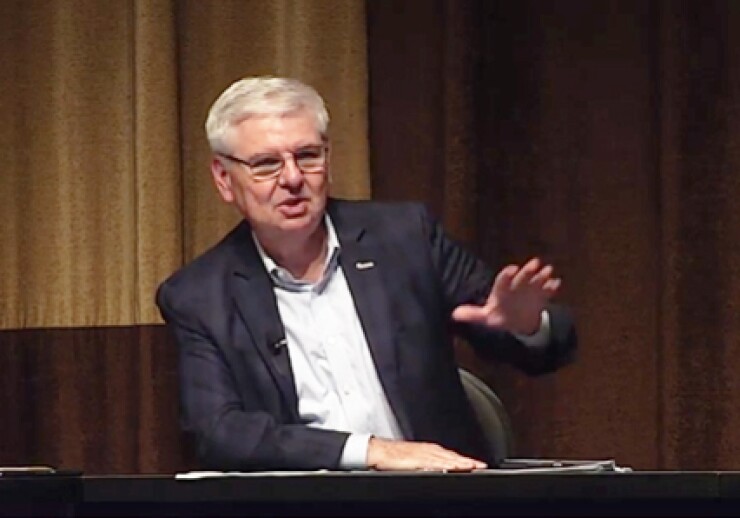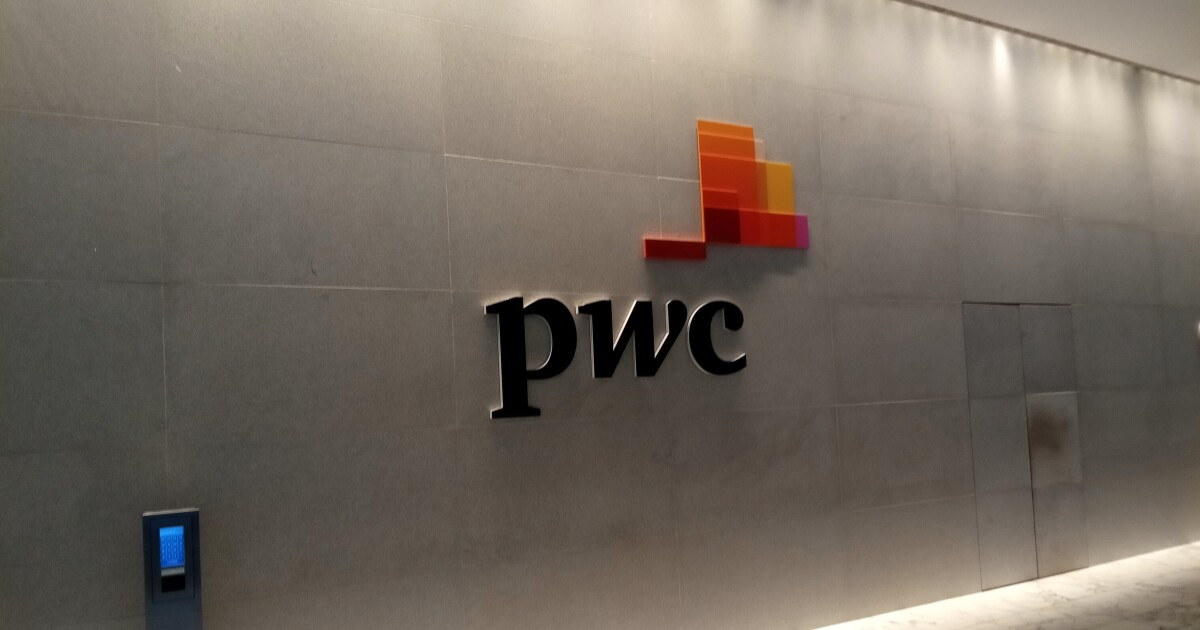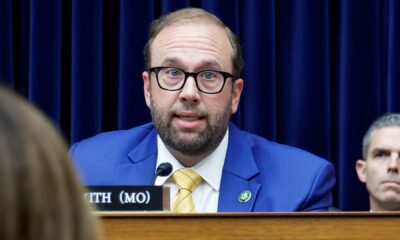Accounting
Barry Melancon: The most important man in accounting
Published
5 months agoon


The most important man in accounting originally intended to be a lawyer.
When Barry Melancon — who is retiring at the end of this year after three decades of leading the accounting profession as president and CEO of the American Institute of CPAs — started college at Nicholls State University in Louisiana in 1975, accounting wasn’t even on his radar.
“If you went back to my high school yearbook, I believe it would tell you that I wanted to be a lawyer,” he recalled, and when he started in his first semester, he was majoring in pre-law.
Coming from what he describes as “a very modest family” — his father had been pulled out of school in sixth grade to cut sugarcane by hand on the family farm — he explained that, “There wasn’t a frame of reference for me, really, about the CPA profession.”
That changed in his second semester, though, because he realized that he wanted to know more about business, and he chose accounting as a concentration largely because it offered the most comprehensive introduction to business: “If I majored in accounting, I would take all the other disciplines, because it was required — I would take management and marketing and economics and finance and, of course, accounting. And it just felt like if I wanted to know business — still probably within the back of my mind being a lawyer — that was going to give me the broadest base of knowledge.”
Then, in an epiphany experienced by countless CPAs before and since, he took the entry-level accounting course and was hooked.
“I liked it — I don’t think it’s the right course and we’re talking about changing it today, and I never thought it was the right course then,” he said. “It was way too mechanical to teach accounting. But I grasped the notion of what accountants really were doing, and so I changed my major into accounting after that first year.”
(See our 2024 list of the
Having made the choice, he charged ahead at full speed, finishing his undergraduate accounting degree in 3 ½ years, quickly landing a job at a small local firm, Bergeron & Co., and making partner there by the unprecedented age of 25. Not long after that he became the head of the Society of Louisiana CPAs, and seven years later he was named the youngest-ever head of the AICPA at 37. (He was actually hired when he was 36, but they delayed his start date until after his birthday so it would look better in the press release.)
By the time he arrived at the institute, Melancon had long since fully committed himself to accounting — and he had strong ideas about where he wanted to take the profession, and that would mean major changes at its main membership organization.
“Professional bodies in any profession usually have a DNA about saying why a profession couldn’t or shouldn’t do things,” he explained. “And I think what we created and what I had a passion about was to be an organization that led a profession, that worked with the profession to actually give permission to be much broader than what it was, to see those opportunities and what was in the best interest of the profession and the public interest — not to be an organization that tried to figure out why you might want to be really careful, or to say you shouldn’t do these types of things.”
While it’s far from the only thing Melancon has accomplished during his long tenure, shifting the AICPA from being an inhibitor to an enabler — and driving the profession as a whole to be more open to new opportunities and approaches and risks — may well be how he’s had the most influence.
“We need to have a mindset of the things we can do, rather than the reasons why we can’t,” he said, “and I think the profession embodies that today.”
Getting it in writing
To understand how Melancon rose to the level where he was able to wield that kind of influence, it helps to know that he had it written on his list of goals from the get-go.
Early in his career at Bergeron, Melancon started keeping a written list (he still keeps it, only now it’s on his phone), because a partner at the firm suggested it.
“One time this partner and I were going to a client, and the partner was building a new house and we passed in front of his house and he said, ‘You see, even before my house is being built, we have a pool in it. I had a written goal.’ This is what he said: ‘I had a written goal to have a pool, and now I’m able to achieve that.’ And he basically impressed upon me — I might have been 21 at that point — how important written goals were.”
And high on the list Melancon started keeping was a goal that sounds an awful lot like a job description for the head of the AICPA: “Literally I had a written goal to fly around, get off a plane and give speeches,” he said with a laugh. “I mean, it wasn’t worded exactly like that.”

AL POWERS
Also on the list was making partner by 25 — an objective he almost didn’t fulfill, because a client offered him a job at a substantially higher salary than he was making at his firm.
“I was at Bergeron & Co. about nine months, and I was making $15,000 a year, and I had a client offer me a job at $25,000,” he recalled. “And when you’re making $15,000, $25,000 is a big increase, right?”
Feeling tempted, he told the partners of the firm about the offer — and even today, 40 years later, he makes a point of telling firm leaders about their response: “What they did is they said, ‘Let’s go to lunch.’ We had a 2 ½-hour lunch and basically they painted a picture for me of what being a partner was going to be like in the firm — basically what they made — and they painted the picture so well and it was one of my goals, that it caused me to say, ‘I am not doing this.’ I’m not leaving because I will always regret not experiencing that outcome.”
Not every goal on the list gets fulfilled, though; for instance, he originally had a goal to retire at 55: “But when I got later in my career, I said that’s a really dumb goal.”
The people around you
Of course, merely willing a thing (even in writing) isn’t always enough to make it come true. It also takes hard work and determination, which Melancon has always been willing to put in — and it certainly helped that leaders all around him recognized his talent early.
“The people around you in your life really determine who you are, and it’s important to understand that,” he said.
The day he passed the CPA exam, for instance, a partner at Bergeron & Co. congratulated him by taking his own name off an LSCPA committee, and having them put Melancon on it.
“So literally I was on a society or a professional committee the first day I was a CPA in my career,” he said, and he only got more involved, chairing committees and putting his minor in government from Nicholls to good use on advocacy work in the state.
(See who the most influential people in the profession
He was so active, in fact, that when the then-CEO of the society moved to the top spot at the Texas state society, both he and the CPA who succeeded him as head of the LSCPA offered Melancon the No. 2 spot at their respective organizations. Having just made partner at Bergeron, he turned them both down — but three years later when the Louisiana position opened up again and the then-chair made it clear that the job was his for the taking, he said yes.
“Really, what my wife and I talked about was that, in reality, we can go do this, and what’s the worst case? If I don’t like it, I can go back into public practice,” he said. “Those doors aren’t going to be closed to me.”
He couldn’t know that he wouldn’t return to public practice, and that his seven years at the Louisiana society would lead to him being so active with the AICPA that he would be considered a potential candidate to succeed then-president and CEO Phil Chenok in the mid-1990s.
But when the call came from search firm Korn Ferry, Melancon initially turned them down, too. “I told them no,” he recalled. “I said, ‘I’m probably too young for the institute to hire me and I don’t think that’s going to happen, and so I don’t think I’m going to put my name in.’ And about a month later, they called me back and they said, ‘Look, people want you to put your name in, and if you put your name in, I can guarantee you that you will be one of nine that gets interviewed.’ So, at that point, it’s sort of hard to say no to that.”
It wasn’t just the accountants recommending him to Korn Ferry who envisioned Melancon at the head of the institute. Much earlier, one of the leaders of the LSCPA saw it too. One component of his compensation involved deferred comp that would be forfeited if he left before serving for 10 years; at the time the position at the AICPA came open, Melancon had served seven years, but “unbeknownst to me, one of the society leaders had written into my contract a provision that said — and I didn’t ask for this — you forfeit unless you leave to be CEO of the AICPA. And that was written when I was 30.”
“It’s people around you who see things in you, at least in my case, that have been unbelievable in life,” he said. “For someone to see that in you, to me, is about what people around you make of you and what people around you contribute to you. When someone that was around me saw that — what an incredible compliment and support mechanism that was — it is amazing. I’ve had a lot of luck.”
Promising change
Melancon put his name in the ring, but still didn’t think he had a chance, even though he flew to California to meet the recruiter from Korn Ferry.
“We were supposed to have a one-hour dinner in the San Francisco airport,” he recalled. “And essentially I started that dinner off with, ‘Look, I didn’t go to a name-brand university. I’m 36 years old. I never worked in a big firm. I’m not from the Northeast. You and I both know that the institute is not going to hire me in this job. So, let me tell you what I think ought to happen.'”
The one-hour dinner ended four hours later, after Melancon had outlined all the changes he thought should be made at the institute. “And when I ultimately got into the role,” he said, “I did a lot of the stuff that we talked about.”

Despite — or perhaps because of — his candor with Korn Ferry, Melancon got the job, and felt empowered to implement the changes he had suggested. “I went in with the notion that people put me here and I was going to change the place,” he said. “And in the first 90 days I did a massive reorganization, including many people being asked to leave the institute.”
He cut headcount at the AICPA from 863 to below 600 (a level it maintained for 20 years, until it merged with the Chartered Institute of Management Accountants in 2016). He also began to build up the institute’s advocacy muscles, speed up its processes, promote high-potential talent (including current CEO of public accounting Sue Coffey), and to change what the institute meant to firms — particularly those below the Big Four, who had not been as engaged with the AICPA before.
“I knew the profession was changing and I knew that the institute could not be what a lot of people would have said that it was then — an ivory tower institute — and I also knew that we had to be more entrepreneurial and that the profession had to be more entrepreneurial and that’s what drove me, and we did it,” he said.
From there to the future
A wholesale reorganization of the leading organization in the profession would be accomplishment enough for many, but for Melancon, it served to give him a strong platform from which to lead accounting into the future.
The three decades of his tenure have been among the most tumultuous, unpredictable and full of change in accounting’s history, and Melancon has taken the lead in navigating the profession through two recessions, the collapse of Arthur Andersen and the Enron crisis, the creation of major new regulatory regimes in the form of Sarbanes-Oxley and the Public Company Accounting Oversight Board, the rise of the internet and the cloud, a global pandemic, and most recently, the birth of artificial intelligence, through all of which he has charted a proactive course forward, rather than merely reacting.
All that time, Melancon and the institute were pursuing their own agenda — computerizing the CPA exam and taking it international, launching
CPA.com as its technology arm, exploring and proselytizing new services, launching initiatives to boost audit quality, working to promote diversity, aggressively pursuing solutions to the current pipeline program, and, perhaps most ambitiously, merging with CIMA to create an international powerhouse.
With so much to do, it’s easy to see why Melancon has stayed in his role longer than any other leader in AICPA history. “I went in at first with a five-year commitment, so you don’t really know how that is going to play out,” he said. “But I had a passion for the profession and I always have had confidence in myself, so I did not go in to the institute with the notion that this was going to be a short-term process.”
Even with his time at the institute almost up, Melancon is still looking forward, seeing the future course of the profession in his mind, spying out both challenges and opportunities.
He highlights artificial intelligence as a transformational technology that will, like the rise of the internet three decades ago, have repercussions for both society at large and the accounting profession.
“I am not one who’s going to say that with AI, the role of the human is going to be fine, or that it’s always going to be there. I don’t believe that at all,” he said. “I believe that just like a lot of other technologies change jobs, change the quantity of jobs in certain areas, change the expectations of what people do in jobs, it’s going to have an impact; it’s going to change how we define work in society not in the next two years but in the next decade.”
AI’s impact on the profession is going to be tied into an ongoing evolution in the structure of firms and how accountants progress in their careers. “The fundamental change for the profession is that we have been a profession that takes entry-level people … we take in entry-level people and we put them in an environment to progress upward to the middle of the organization,” he explained. “And it takes a while, and the key component of that is a broader set of competencies than just accounting and a broad notion of what you can call business acumen. And when you get to the middle part of an organization, whether it’s a finance function or a firm, your value-add to a client or to your employer is really about those broader skills and your business acumen.”
“Organizations like the AICPA and firms and professional accountancy bodies around the world need to think about how we take an entry-level accountant where technology is going to do the bulk of that entry-level accounting work and how we move them up quickly and get them those broader skills quicker so that they’re value-add players,” he explained. “It is an immense challenge, but we’re going to have to figure it out. And if we figure it out, then starting from human capital, our services are going to change.”
Those challenges will be for the next generation of leaders of the profession to deal with, but Melancon does have some advice for the accountants of the future — and it is, naturally, about taking a broader view of what they, and the profession, can do.
“If we go into every morning and we think, ‘We know accounting,’ we’re not going to have the same future as if we think, ‘We know business information,'” he said. “We really need to take our skills and our competencies and apply it to the broader footprint of business and do it right and effectively, with ethics. And if we do that, we’re going to have a lot of new and different opportunities, and the next generation of our profession is going to be even more successful than the current generation of our profession.”
Much of Melancon’s career can be summed up by a relentless drive to move accounting forward, to improve every aspect of it — but as he looks back, it’s not the impact he has had on the profession that is foremost in his mind, but rather the impact that the people in the profession had on him.
“I would thank the people that I have interacted with, the people in our profession, for how much I’ve learned from so many different people,” he said. “I find it really hard to believe someone can have a career that gets exposed to anything like what I’ve been exposed to, because CPAs and the profession are fantastic, and the people who interact with you and the questions they ask and the contributions they make are just tremendous. … And that knowledge makes one’s life — in my case, my life — so incredibly enjoyable and fulfilled that I’m very appreciative of the profession.”
You may like


Leigh Prather/Leigh Prather – Fotolia
It is getting a little difficult to talk about a post-tax filing season after April 15, 2025. With the use of tax extensions and the number of disaster-relief related extensions, many tax return preparers are seeing the tax filing season continue through the summer and fall.
It was the 70th anniversary of the April 15 tax filing deadline this year. Still, the statistics being reported by the Internal Revenue Service look fairly normal compared to the 2024 tax filing season. By April 18, 2025, the IRS reports that 140,633,000 tax returns had been filed, up about 1.1% from 2024. The IRS notes that typically an additional 10% of returns will be filed by the extended tax deadline of Oct. 15, 2025, representing an additional 16% of tax revenue.
(Read more: “
Further, all or part of 10 states had filing deadlines extended due to natural disasters, with filing deadlines ranging from May 1, 2025, to Nov. 3, 2025. The IRS typically releases an additional filing update in mid-July.
Tax refunds for 2025 of 86,021,000 were similar to 2024. The refund amount was an average of $2,942, up 3.3% from 2024. E-filings by tax professionals were 72,504,000, up by 1.7% from 2024, while self-prepared e-filings were up more modestly to 63,726,000. One interesting statistic from the IRS was that visits to IRS.gov were down significantly from 571,496,000 in 2024 to 322,948,000 in 2025.
The 2025 tax return itself was not too different compared to 2024, except for the usual inflation adjustments. Additional Form 1099-K filings perhaps made the most significant change for 2025 filings.
There were a few provisions from prior tax legislation still coming into effect in 2024, such as the ability to transfer the Clean Vehicle Credit to the dealer, which did result in some confusion and at least temporarily rejected claims for the credit.
Congress in 2024 did not adopt any major tax legislation to add further changes. The 2026 tax filing season could look very different depending upon whether Congress manages to pass new tax legislation this year. Tax professionals will have the expiration of the individual provisions of the Tax Cuts and Jobs Act to deal with if Congress does not act, and potentially new changes to deal with if Congress does act, although it is not clear how many of those changes might be effective for 2025.
Congress
Congress has approved a budget framework for a budget reconciliation tax package with a focus on extending those individual provisions from the Tax Cuts and Jobs Act. However, Congress is also trying to squeeze in some or all of President Trump’s tax proposals, including no tax on Social Security benefits, no tax on overtime, no tax on tips, a possible reduction in the corporate tax rate for domestic manufacturers, a deduction for interest on car loans, and perhaps a modification of the state and local tax deduction limit.

Possible revenue offsets to come within the budget framework numbers include spending cuts, tariff revenue, assumptions about economic growth resulting from the legislation, repeal of some clean energy credits, and using a budget gimmick to assume that extending current provisions in the Tax Code do not require revenue offsets, even though they add to the deficit.
It will be difficult to accomplish everything that congressional Republicans hope to include while also appeasing the deficit hawks among their members and Republican moderates vowing to preserve Medicaid.
The House has already introduced a series of tax bills addressing matters such as timing of receipt of electronic submissions, communication of math adjustments, disaster relief (including tying relief to state as well as federal disaster declarations), the ability to replace stolen checks electronically, and a bill to enhance certain administrative functions.
IRS
For the IRS, along with most of the federal government, it was far from a normal tax season. Having just staffed up for more enforcement, customer service, and technology improvements thanks to funding from the Inflation Reduction Act, the IRS is now facing a possible 25% reduction in its workforce through a deferred resignation program and a voluntary separation incentive program.
In addition, although it is still tied up in the courts, there may still be departures of provisional employees. Leadership at the IRS has also been unstable, with three interim IRS commissioners since IRS Commissioner Daniel Werfel resigned on Jan. 17, 2025.
Other changes announced by the IRS include elimination of the beneficial ownership information reporting requirement for domestic entities and declaring obsolescent a variety of old guidance.
(Read more: “
Congress acted to overturn the IRS requirement for crypto broker DeFi reporting on Form 1099-DA. The IRS also announced the withdrawal of the final regulations on partnership basis-shifting transactions involving related parties as a transaction of interest.
However, Revenue Ruling 2024-14 appears to remain in effect, providing that the economic substance doctrine applies where basis shifting among related parties does not have economic purpose or substance. There are also indications that the IRS Direct File program, which was around for 2024 and 2025, will not be continued for future years.
Summary
The relative stability of the 2025 tax filing season is likely to be very different next tax filing season. Congress hopes to pass major tax legislation, some of which will preserve the status quo but other parts of which will present new tax filing challenges.
It is still too early to ascertain the impact on the IRS; however, the loss of so many employees and leadership turnovers point to less enforcement and compliance activity, and less revenue collected from such activities, including a pullback of the effort to increase partnership audit activity. There could also be a return to declines in customer service.
At the American Bar Association Tax Section meeting in Los Angeles in February 2025, no representatives of the Treasury or the IRS were permitted to attend or participate in the usual discussion panels.
At the time of this writing, the next meeting of the Tax Section was due in mid-May, in Washington, D.C. It will be interesting to see if government panelists are permitted to go the few blocks to the conference. Usually, the exchange of ideas is very helpful to the tax professionals in attendance and to the government personnel seeking comments on proposed guidance.


Big Four firm PwC announced new agentic AI capacities, including a model that proactively identifies areas of value leakage and acts inside the tools teams already use to fix them itself.
The new solution,
The software, which is supported by PwC’s recently released
The system connects directly into ERP environments, continuously monitors key metrics, and acts inside the tools teams already use. For example, a supply chain agent might detect rising shipping costs and automatically reroute deliveries to reduce spend. Finance agents can spot and correct billing errors before they reach the customer. Clients typically see measurable efficiency gains in the first quarter, with continued improvements over time as the system learns and adapts.
“Too many transformations still rely on one-off pilots and stale data, stretching the gap from insight to impact and suffocating ROI,” said Saurabh Sarbaliya, PwC’s principal for enterprise strategy and value. “Agent Powered Performance flips the economics by distilling PwC’s industry transformation playbooks into AI agents that turn static insights into compounding gains, without rebooting each time.”
Agent Powered Performance is platform-agnostic and built on an open architecture so it can work across different LLMs based on client preferences and task-specific needs. It works with major enterprise platforms including Oracle, SAP, Workday and Guidewire.
Agent OS Model Context Protocol
PwC also
By integrating this standard, agent systems registered as MCP servers can be used by any authorized AI agent. This reduces redundant integration work and the overhead of writing custom logic for each new use case. By standardizing how agents invoke tools and handle responses, MCP also simplifies the interface between agents and enterprise systems, which will serve to reduce development time, lower testing complexity, and cut deployment risk. Finally, any interaction between an agent and an MCP server is authenticated, authorized and logged, and access policies are enforced at the protocol level, which means that compliance and control are native to the system—not layered on after the fact.
This means that agents are no longer siloed. Instead, they can operate as part of a coordinated, governed system that can grow as needs evolve, as MCP support provides the interface to external tools and systems. This enables organizations to move beyond isolated pilots toward integrated systems where agents don’t just reason, but act inside real business workflows. It marks a shift from experimentation to adoption, from isolated tools to scalable, governed intelligence.
Research Composer
Finally, a PwC spokesperson said the firm has also launched a new internal tool for its professionals called Research Composer, a patent-pending AI research agent embedded in the firm’s ChatPwC suite, designed to accelerate insight generation by combining web data with PwC-uploaded content.
Professionals will use the Research Composer to produce in-depth, citation-backed reports for either the firm or its clients. The solution is intended to enhance the quality of client work by equipping teams with research and strategic analysis capabilities.
The AI agent prompts users through a step-by-step research workflow, allowing them to shape how reports are packaged—tailoring the output to meet strategic needs. For example, a manager in advisory services might use Research Composer to evaluate white space opportunities across industries or geographies, drawing from internal reports and up-to-date market data.


Eide Bailly, a Top 25 Firm based in Fargo, North Dakota, is growing its presence in the Pacific Northwest by adding Traner Smith, based in Edmonds, Washington, effective June 2, 2025.
Traner Smith’s team includes two partners and 16 staff members and specializes in tax compliance and advisory services. Financial terms of the deal were not disclosed. Eide Bailly ranked No. 19 on
Eide Bailly already has offices in Seattle, but hopes to grow further in the Pacific Northwest. “We’re pleased to welcome the talented team at Traner Smith to Eide Bailly,” said Eide Bailly managing partner and CEO Jeremy Hauk in a statement Monday. “Their expertise with high-net-worth individuals, real estate and privately held businesses aligns well with our strengths, and their client-centric approach is a perfect cultural fit. Having an office in Edmonds, Washington, is a great complement to our existing presence in Seattle. Together, we’re poised to deliver even greater value to families and businesses in the Seattle metro area.”
“Joining Eide Bailly is a natural next step for us — it provides access to deeper technical resources in areas like state and local tax, national tax, succession planning and international tax while allowing us to continue the personalized service our clients value,” said Kevin Smith, a partner at Traner Smith, in a statement.
“With this expanded support and platform, we’re excited to grow our reach, elevate what we do best, and help more clients than ever before,” said Shane Summer, another partner at Traner Smith, in a statement.
Eide Bailly has announced several other mergers in recent weeks. Earlier this month, it added
In 2023, Eide Bailly added

Student loan delinquencies risk ‘spillovers’ to other debts, NY Fed

Tax Strategy: Post-tax filing season update

HD, AS, VIK & more

New 2023 K-1 instructions stir the CAMT pot for partnerships and corporations

The Essential Practice of Bank and Credit Card Statement Reconciliation

Are American progressives making themselves sad?
Trending
-

 Accounting1 week ago
Accounting1 week agoEssential Strategies for Maintaining Data Security in Modern Bookkeeping
-

 Economics1 week ago
Economics1 week agoCPI inflation April 2025: Rate hits 2.3%
-

 Economics1 week ago
Economics1 week agoTariff receipts topped $16 billion in April, a record that helped cut the budget deficit
-

 Economics5 days ago
Economics5 days agoViolent crime is falling rapidly across America
-

 Personal Finance6 days ago
Personal Finance6 days agoHouse Republicans advance Trump’s tax bill. ‘SALT’ deduction in limbo
-

 Economics1 week ago
Economics1 week agoGerman business leaders tell new government: It’s time to deliver
-

 Economics4 days ago
Economics4 days agoThe low-end consumer is about to feel the pinch as Trump restarts student loan collections
-

 Personal Finance1 week ago
Personal Finance1 week agoHow to save on groceries amid food price inflation
